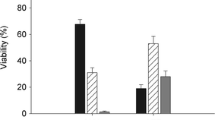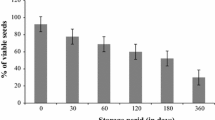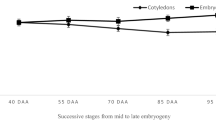Abstract
The germination requirements of five Senna species: S. bicapsularis, S. didymobotrya, S. multiglandulosa, S. occidentalis and S. septemtrionalis have been investigated. Seeds possess dormancy which is caused by their hard seed coats hampering maximum, uniform and rapid germination. To overcome this dormancy, seeds of the five species were pre-treated with (a) mechanical scarification, (b) concentrated sulphuric acid for 15, 30, 45 and 60 minutes and (c) boiling water for 15, 30, 45 and 60 seconds. To determine the effects of temperature on the germination of seeds, pre-treated seeds from each species were incubated at 10, 15, 20, 25 and 30°C. Germination was also tested in the dark. Both acid treatment and mechanical scarification resulted in fast and uniform germination. The highest germination (95–100%) for all species was obtained from seeds treated with sulphuric acid for 60 minutes. Mechanical scarification resulted in 100% germination in all the species except S. septemtrionalis (59%). Boiling water improved germination significantly in S. didymobotrya (98%), S. occidentalis (82%) and S. septemtrionalis (97%), but had very little effect on S. multiglandulosa and reduced germination in S. bicapsularis. Senna seeds germinated over a wide range of temperatures with the optimum temperatures for germination falling around 20–25°C. Germination was either completely inhibited or very low at 10°C. Seeds of all species germinated both in light and dark conditions.
Similar content being viewed by others
References
Araujo, M.A.S., Santos, D.M.M. Dos and Piccolo, A.L.G. 1983/84. Estudo da germinaçào de sementes de Cassia multijuga L.C. Rich. (Leguminosae-Caesalpinioideae). Garcia de Orta Botânica 6: 13–16.
Babeley, G.S. and Kanday, A.K. 1988. On finding out some suitable pre-treatments for Cassia jistula L. seeds. J. Trop. Fores. 4: 147–154.
Ballard, L.A.T. 1973. Physical barriers to germination. Seed Sci. and Technol. 1: 285–303.
Baskin, J.M. and Baskin, C.C. 1989. Physiology of dormancy and germination in relation to seed bank ecology, pp. 53–66. In: Leck, M.A., Parker, V.T. and Simpson, R.L. (Eds) Ecology of Soil Seed Banks. Academic Press, San Diego, California.
Bewley, J.D. and Black, M. 1982. Physiology and Biochemistry of Seeds in Relation to Germination, vol. 2. Springer Verlag, Berlin, Heidelberg, Germany, 375 pp.
Cavanagh, A.K. 1980. A review of some aspects of the germination of Acacias. Proc. Royal Soc. Victoria 91: 161–180.
Cavanagh, T. 1987. Germination of hard-seeded species (Order Fabales), pp. 58–70. In: Langkamp, P. (Ed) Germination of Australian Native Plant Seed. The Australian Mineral Industries Research Association Limited, Melbourne & Sydney.
DemelTeketay. 1993. Germination ecology of Vernonia galamensis (Cass.) Less. var. ethiopica M.G. Gilbert, a new industrial oilseed crop. Trop. Ecol. 34: 64–74.
DemelTeketay. 1994. Germination ecology of two endemic multipurpose species of Erythrina from Ethiopia. For. Ecol. Manage. 65: 81–87.
Fenner, M. 1985. Seed Ecology. Chapman and Hall, London and New York, 151 pp.
Hedberg, I. and Edwards, S. (Eds). 1989. Flora of Ethiopia, vol. 3. The National Herbarium, Addis Abeba, 660 pp.
Irwine, F.R. 1961. Woody Plants of Ghana, with Special Reference to Their Uses. Oxford University Press, London, 868 pp.
Kumari, A. and Kohli, R.K. 1984. Studies on dormancy and macromolecular drifts during germination in Cassia occidentalis L. seeds. J. Tree Sci. 3: 111–125.
Rai, S.N., Nagaveni, H.C. and Padmanabha, H.S.A. 1986. Germination and viability of some tree seeds. Van-Vigyan 24: 8–12.
Robertson, F.C.F. 1948/49. The pre-treatment of forest seed to hasten germination. For. Abstr. 10: 1–11.
Rolston, M.P. 1978. Water impermeable seed dormancy. Bot. Rev. 44: 365–396.
Sharf El Din, M.N., Hamza, A.M., Zimmer, K. and Abd El Kafie, O.M. 1988. Effect of scarification methods on seed germination of Delonix regia and Cassia fistula. J. Agr. Sci. Mansoura Univ. 13: 2381–2385.
STSC. 1986. STATGRAPHICS. Statistical Graphics Corporation, EXEC*U*STAT, Inc., and Lauer Software, U.S.A.
Thulin, M. 1989. Fabaceae, pp. 49–251. In: Hedberg, I. and Edwards, S. (Eds) Flora of Ethiopia, vol. 3. The National Herbarium, Addis Abeba.
Todaria, N.P. and Negim, A.K. 1992. Pre-treatments of some Indian Cassia seeds to improve their germination. Seed Sci. and Technol. 20: 583–588.
Willan, R.L. 1985. A guide to forest seed handling. FAO Forestry Paper 20/2. FAO, Rome, 379 pp.
Williams, W.A. and Elliott, J.R. 1960. Ecological significance of seed coat impermeability to moisture in Crimson, Subterranean and Rose Clovers in a Mediterranean-type Climate. Ecology 41: 733–742.
Zar, J.H. 1984. Biostatistical Analysis, 2nd Edn. Prentice-Hall, Englewood Cliffs, New Jersey, 718 pp.
Author information
Authors and Affiliations
Rights and permissions
About this article
Cite this article
Teketay, D. The effect of different pre-sowing seed treatments, temperature and light on the germination of five Senna species from Ethiopia. New Forest 11, 155–171 (1996). https://doi.org/10.1007/BF00033411
Received:
Accepted:
Issue Date:
DOI: https://doi.org/10.1007/BF00033411




